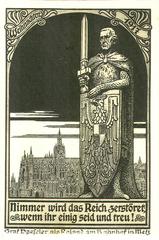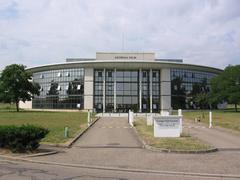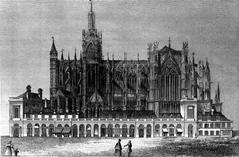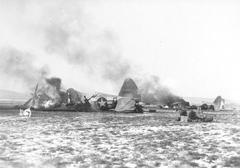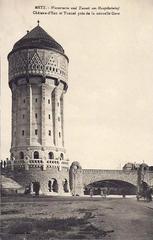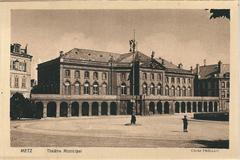
Germans’ Gate Metz: Visiting Hours, Tickets & Historical Sites Guide
Date: 04/07/2025
Introduction
Nestled in the heart of Metz, France, the Germans’ Gate (Porte des Allemands) is one of the city’s most impressive medieval landmarks and France’s last remaining bridge-castle. Built in the 13th century as both a fortified gateway and bridge over the Seille River, it embodies Metz’s layered history as a crossroads of French and Germanic cultures. Its name, referencing the nearby Teutonic Knights’ hospital, highlights this unique heritage. Over the centuries, the Germans’ Gate has played critical roles in military defense, witnessed sieges, adapted to new forms of warfare, and survived through various periods of conflict. Today, it is a protected historical monument and a vibrant cultural symbol, offering visitors a window into medieval architecture and the city’s dynamic past (Trek Zone; Metz Tourism Office; FranceRent).
Whether you are a history enthusiast, a traveler, or a local, this guide provides all the essential details for visiting the Germans’ Gate—covering its origins, architecture, cultural significance, practical information, and nearby attractions.
Table of Contents
- Medieval Origins and Architectural Evolution
- Strategic Role in Metz’s Fortifications
- Adaptation Through the Early Modern Period
- Preservation and Restoration
- Cultural and Symbolic Significance
- Key Historical Events
- Visitor Experience: Features & Tours
- Visiting Information: Hours, Tickets, Accessibility
- Travel Tips & Nearby Attractions
- Frequently Asked Questions (FAQ)
- Conclusion
- References
Medieval Origins and Architectural Evolution
Constructed between 1230–1250, the Germans’ Gate was conceived as a vital defensive structure—a fortified bridge and gate controlling entry from the east into Metz. Its name, “Porte des Allemands,” is derived from the nearby Hospital of the Teutonic Knights (“Allemands” in French), established in the 13th century. Over time, the gate was expanded, particularly in the 15th century, with the addition of two massive round towers and a fortified barbican. These enhancements reflected the evolution of siege warfare and the growing importance of artillery, resulting in thicker walls and reinforced parapets (Trek Zone).
The Germans’ Gate integrates both Romanesque (rounded towers) and Gothic (pointed arches, ribbed vaults) architectural elements. Later modifications during the Renaissance introduced gunports and bastions, adapting the structure for early modern military needs.
Strategic Role in Metz’s Fortifications
Metz’s position at a European crossroads made it a target for various powers. The Germans’ Gate formed a key part of the city’s defenses, guarding the approach from the Seille River and the road towards Germany. Its formidable towers, arrow slits, and machicolations (openings for dropping projectiles) were essential features in repelling invaders. The gate’s robust design allowed it to withstand sieges, notably during the 1552–1553 siege by Emperor Charles V, and reinforced Metz’s status as a free imperial city within the Holy Roman Empire (Trek Zone).
Adaptation Through the Early Modern Period
With the adoption of gunpowder and artillery from the 16th century onwards, the Germans’ Gate and surrounding fortifications underwent further modifications. Thicker walls and additional gunports were added to counter new threats. During the late 19th century, after the Franco-Prussian War and Metz’s annexation by the German Empire, the Germans’ Gate was incorporated into the broader Moselstellung military system, though its frontline defensive role diminished over time (Trek Zone).
Preservation and Restoration
While much of Metz’s medieval fortifications were dismantled in the 19th and 20th centuries to make way for urban expansion, the Germans’ Gate was preserved thanks to its historical and architectural value. Restoration efforts stabilized the structure, repaired masonry, and preserved original features such as the crenellated parapets and vaulted passageways. Today, it is a protected historical monument and a celebrated landmark (anecdotrip.com).
Cultural and Symbolic Significance
The Germans’ Gate is often called the “last medieval bridge-castle in France,” a testament to its unique hybrid form as both a gateway and a bridge. Its silhouette, with twin towers and a fortified span over the river, is a defining image of Metz. The gate is woven into the city’s identity, appearing in art, literature, and local celebrations, and remains a powerful symbol of Metz’s resilience and multicultural heritage (FranceRent; WorldCityTrail).
Key Historical Events
- Siege of 1552–1553: The Germans’ Gate played a critical defensive role during Metz’s resistance to the Holy Roman Emperor Charles V.
- Franco-Prussian War (1870): Following the war, Metz and its fortifications were integrated into the German Empire’s defensive strategies.
- World Wars: The gate survived significant damage during World War II and was subsequently restored, symbolizing the city’s endurance (anecdotrip.com).
Visitor Experience: Features & Tours
Architectural Features
- Twin Towers: Cylindrical, built from local Jaumont limestone, with pepper-pot roofs.
- Fortified Bridge: Spans 30 meters over the Seille River.
- Defensive Elements: Machicolations, arrow slits, gunports, and a former portcullis.
- Interior Spaces: Vaulted passageways, guardrooms, and parapet walks.
- Exhibitions: Occasional displays on Metz’s medieval defenses and city history.
Guided & Self-Guided Tours
- Interpretive Panels: Onsite information in French and some English.
- Guided Tours: Led by local experts or cultural mediators; available on select days (typically Saturdays at 16:00 year-round, and Wednesdays at 16:00 from May to September) (metz.fr).
- Audio Guides: Interactive experiences via the Audiala app and other platforms.
Visiting Information: Hours, Tickets, Accessibility
- Opening Hours: The exterior is accessible year-round at any time. Interior spaces (including towers and galleries) are generally open Tuesday to Sunday, 10:00 AM to 6:00 PM (last entry 5:30 PM), closed Mondays and on public holidays. Hours may vary seasonally—always check ahead (Metz Tourism Office; theadventurelion.com).
- Tickets: Entry is free for both self-guided and guided tours. Some exhibitions or special events may have a fee, but general access is complimentary.
- Accessibility: The bridge and exterior areas are accessible to most visitors. Interior towers and upper galleries involve stairs and uneven surfaces, limiting access for those with mobility challenges. Assistance is available upon request.
- Facilities: No restrooms or cafés onsite, but amenities are available nearby in the city center (reisenaround.com).
Travel Tips & Nearby Attractions
- Best Times to Visit: Early morning or late afternoon for optimal lighting and fewer crowds.
- Getting There: Walkable from the city center and major sites; parking available near Metz Cathedral. Well-served by public transport.
- Nearby Attractions:
- Metz Cathedral (Gothic masterpiece)
- Place Saint-Louis (medieval arcades, cafés, shopping)
- Musée de la Cour d’Or (local history and archeology)
- Centre Pompidou-Metz (modern art museum)
- River walks along the Seille (reisenaround.com)
- Dining: Numerous cafés and restaurants are just a short walk away.
- Events: Germans’ Gate hosts exhibitions, cultural events, and private functions. Check the Metz city agenda for current listings.
Frequently Asked Questions (FAQ)
Q: Is there an entrance fee to visit Germans’ Gate?
A: No, entry is free for both self-guided and guided tours.
Q: What are the visiting hours for the interior spaces?
A: Typically Tuesday–Sunday, 10:00 AM to 6:00 PM. The exterior is open year-round. Always consult the latest schedule.
Q: Is the Germans’ Gate accessible for wheelchair users?
A: The exterior and bridge are accessible, but interior areas have stairs and may be challenging.
Q: Are guided tours available?
A: Yes, free guided tours are offered on specific days; check the Metz city agenda for schedules.
Q: What other sites are nearby?
A: Metz Cathedral, Place Saint-Louis, Musée de la Cour d’Or, Centre Pompidou-Metz, and river walks.
Conclusion
The Germans’ Gate is a captivating emblem of Metz’s medieval fortifications and Franco-German heritage. As France’s last remaining bridge-castle, it offers a unique glimpse into the city’s military ingenuity, architectural beauty, and resilient spirit. Whether you are interested in history, architecture, or culture, a visit to the Germans’ Gate is an essential part of any trip to Metz. Be sure to check current opening hours, consider joining a guided tour, and explore nearby neighborhoods for a truly immersive experience. Enhance your journey with the Audiala app for interactive audio tours and up-to-date site information.
References and Further Reading
- Trek Zone: Fortifications of Metz
- Official Metz Tourism Website
- German Gate in Metz - FranceRent
- The Germans’ Gate in Metz: Navaway
- WorldCityTrail: German Gate in Metz
- The Walking Parrot: What to Visit in Metz
- Anecdotrip: History of Germans’ Gate
- Triphobo: Porte des Allemands
- The Adventure Lion: Things to See in Metz
- Reisen Around: Metz, France
- Metz City Agenda
- Tourisme Metz


























